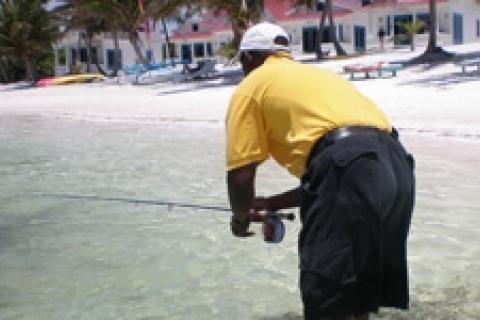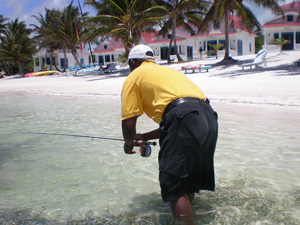
 It's dawn and the eastern sun hauls up a "Japanese" sunrise with bars of blue, yellow and orange into the darker gray sky aloft. A gentle breeze picks up and sends a welcome surge of cool air around you. Only a hundred yards offshore, the sounds of the sea breaking over the barrier reef are matched with a whitish color as the day begins.
It's dawn and the eastern sun hauls up a "Japanese" sunrise with bars of blue, yellow and orange into the darker gray sky aloft. A gentle breeze picks up and sends a welcome surge of cool air around you. Only a hundred yards offshore, the sounds of the sea breaking over the barrier reef are matched with a whitish color as the day begins.
As you walk along a seemingly endless sugar-sanded beach topped by lush coconut palm forests, you see two bonefish tailing barely 3 feet from the water's edge. You keep your gaze on these fish in breathless awe and a thousand heartbeats as you ease your way in a stealthy crouch to get within casting distance.
Suddenly, the two fish ease off the turtle grass pasture and down into long amber tidal pool perhaps thirty feet long. In the day's early light it's impossible to see into this slightly deeper scallop of water, so you quickly change to a weighted fly to fan-cast this gentle scoop of a sanctuary along the tropical beach.
With one false cast, you easily drop the fly against the turtle grass wall 20 feet away and let your fly sink into the basin. With the rod pointed right at the fly, you begin short little strips. A gull screams overhead and you look upward. When you look back at the fly in preparation to pick it up, you see both bonefish bearing down in pursuit, but your offering is only 2 feet off the beach and both of the ghosts explode in alarm as their backs suddenly pop out of the water. Off they fly back into the basin, then over the grass flat leaving a bulging wake until they disappear into some sandy depths further offshore.
All that seems to be left is your panting breath singing a duo with the gentle roar of the reef. Welcome to Ambergris Caye, my friend!
It would seem that scenes like these more likely belong to South Seas islands like Tahiti, but the happy truth is that this exciting prolific destination is less than a 2-hour flight from Houston or Miami to Belize City with just a 15-minute transfer flight to San Pedro, the island's main "town." Though Ambergris Caye is part of Belize, this offshore gem belongs more to Adventure Earth itself. It is a tropical paradise rimmed by endless flats, lush beaches, abyssal blue water, and one of the largest barrier reefs in the world.
To the Planner Goes the Spoils
I've always worked with the maxim that the more unpressured an angling destination is, the better the fishing will be- even in exotic locales like Ambergris. So, it was without hesitation that I chose Tranquility Bay Resort. This marvelous full-service dive and fishing boutique lodging lies over a dozen miles north of laid-back San Pedro and just inside the northernmost cut in the barrier reef. I suspected that would put me smack dab in the middle of a very prolific and varied fishery...and was I ever right!
Underway
The all-too-brief Tropic Air transfer flight took my wife, Shermin, and I over some gorgeous inshore and offshore habitat and soon, the plane eased down onto a strip that was literally in the middle of San Pedro. We had a cab waiting for us and the ride to the dock where our transfer panga was moored took less than 60 seconds. When we arrived at the pier, our guides Gordo and Roy greeted us and then loaded our luggage and tackle onto the twin-engine center console panga. We waited for two other couples who were thankfully, divers, and then we shoved off.
Our trip to Tranquility Bay Resort took us barely forty minutes, yet the trip was full of excited conversations and greetings punctuated by numerous sighting of huge barracudas, giant houndfish, and a few permit blasting out of our vessel's path.
Arrival and a Hot Night
On arrival, Carlos and Isabelle Settle — the lodge managers — were waiting at the dock to greet us. They confirmed our prior plans for three days of guided fishing in the channels, flats, and reef and clarified that the fishing would be done out of a 25-foot center console vessel, an 18-foot tiller-operated panga, or on foot: whichever would best suit our needs for safety and good results.
After check-in, we settled into our beautiful Yucatan/Caribbean style 2-bedroom, 2-bath cabana well situated barely 50 feet from the water. As we sat on our front porch, the brisk easterly winds sent the welcome aroma of cooking our way. There was no need for any meal bell to ring since, just like bonefish, our snoots told us food was at hand.
After an excellent dinner of fresh shrimp, Belizean-style grouper with rice and beans and some key lime pie, we settled into our chairs outside the Tackle Box Bar and restaurant and relaxed. Carlos came over shortly to let me know that the waters right under us should come alive with gamefish after the sun went down and the pier lights went on. I politely listened, though again, lots of research already had me prepared for what was a nightly appearance of tarpon, jacks, barracuda and who-knew-what-else during decent weather. Indeed, back in the cabana, two 10-pound spinners rigged with 40-pound fluorocarbon leader and one eighth-ounce Backbone jigs were perched in a corner just waiting for me to pick them up.
I waited until 1 a.m. before fishing the dock so I could be sure all human activity was over for the night and the fish would be more relaxed. When I peeked over the dock, I was stunned by all the tarpon — possibly 40 in number — swimming into the current waiting to pick off shrimp, crabs and minnows. Alongside them were about 30 houndfish as well as some huge barracuda also finning out. Then, a big school of brown cownose rays swam out of the shadows and into the dock lights. It would turn out that the rays would rhythmically ease back into the light every five minutes or so.
I made my first cast upcurrent of all the fish and worked it naturally back towards all these targets. A tarpon struck the jig on the third rod sweep and jumped itself off the jig. Since it would take a book chapter to really cover this and the next nights' action, I'll summarize the results with 4 tarpon to 30 pounds released, another 15 struck or jumped, 6 big crevalle jacks, 1 (10-pound) horse-eye jack, and another 20 assorted snappers, grunts and blue runners. I couldn't get those big 'cudas to strike the jig at night, but the following day was another story.
Day One
I learned that Gordo and Roy would be my co-captains for all the fishing (big boat, panga, on foot), which made handling of all the bait. lures and tackle easier. We spent our first day fishing live bait (large pilchards) and lures in the reef channel. I was able to catch some nice-sized cero mackerel on white Spro bucktails, though a few of them had cut me off.
We fished live bait both on the bottom and on the top using 30-pound conventional tackle. As the easterly winds were brisk against an outgoing tide, our surface live baits were not productive.
As soon as we dropped the same baits to the bottom, they were savagely attacked by small to medium snappers and some huge porgies. I kept a few of these fish in the livewell as I wanted to give the huge barracudas at the resort's dock something they'd want to eat.
The highlights of fishing this channel were about a half-dozen strikes by fish that proved unstoppable on locked -down drags with 30-pound line. They simply blasted the baits, got solidly hooked, and then made blazing runs against impossibly tight drags until they fouled us in the bottom structure fifty feet below us. My guess is that they were big black groupers.
Back at the dock, I rigged the heavy rods with number seven wire leader and live grunts for those monster 'cuda. I had two hard strikes resulting in one fish jumped off from my striking prematurely and a cutoff as the second fish-well over forty pounds- sliced my line as it swam through the pilings beneath me.
Day Two
The preludes to this day of guided fishing were another obsessive bout of night fishing the dock lights, two hours of sleep, then greeting the dawn by some self-guided beach flat fishing where I released two bonefish caught on jigs. I returned to our cabana, fell into a hard sleep and left poor Gordo and Roy waiting for me until I came to my senses at 10 a.m.
By that time, the tide was ebbing almost all the way out. While this might be good around typically mangrove-fringed Bahamian and Caribbean islands, in this "South Seas" habitat, it meant that the bones retreated to the tidal pools and blue holes. As I eased into the small panga, the three of us agreed to run two mile south to a deeper flat more appropriate to this tidal stage.
When we arrived, we saw some tailing fish that quickly disappeared. Roy poled us to a blue hole in the middle of the flat and anchored on its' edge. In three hours of casting in this area, I released two more bonefish and more barracuda than I care to recall. Since I was casting jigs, I had many cutoffs that might otherwise have hooked more bonefish.
Day Three
Our last day was devoted to fishing the "patches" inside of the barrier reef. Although Gordo assured me we'd have good action right off Tranquility Bay, he had some hot spots 3 miles to the north. Since our skiff would have to navigate in and around some reefs close to the surface, we waited until 10 a.m. to get an optimal sun angle into the water.
After a quick run and some labyrinthine piloting among the patches, Gordo cut the engine and started poling in the six-foot deep water. Before long, he pointed to the 2 o'clock position and said, "there." I was astonished at the sight of about two hundred fish finning right on the surface and they appeared to be big snappers.
I could barely contain my excitement as Gordo poled the skiff upcurrent of the fish and Roy gently let out the anchor. I cast my bucktail about five feet in front of this mass of red gamesters and swept the rod only one time before it doubled over. I used maximum pressure and a super tight drag against this battler. A minute later, Roy was releasing a beautiful four-pound schoolmaster snapper, which is large for this species.
The next four hours were constant action on jigs and, then, cut pilchard heads hooked through the eyes. We had to release all of the schoolmaster, mutton snapper, and mangrove snapper since we were in park waters. Our rough count indicated a good hundred fish released and twice that many lost in cutoffs.
As Roy motored the skiff back towards the lodge, my only thoughts were how quickly I could get back to Tranquility Bay.
Important Facts About Ambergris Caye-
Official language- English, then Spanish and Creole.
Transportation- Mainly by golf cart, then by car.
Climate- Tropical and sub-tropical with average temperatures in the upper 70's. Same rainy season as in Florida.
Currency- The U.S. dollar is widely accepted and is about twice the Belizean equivalent.
Dress- Informal as need be.
- 8364 views

